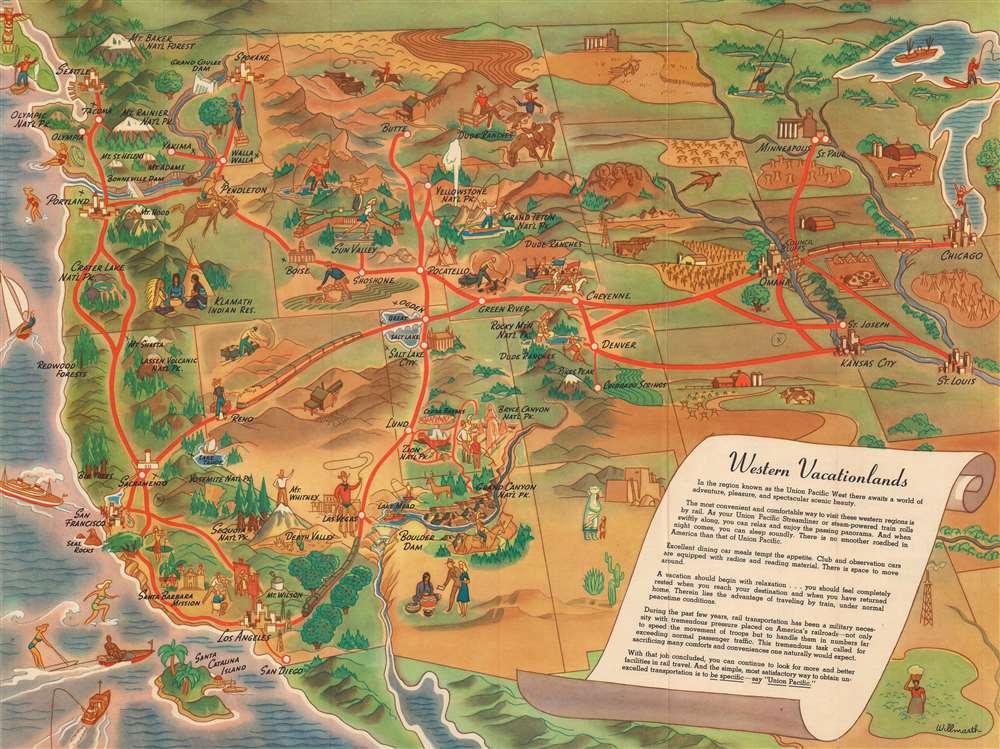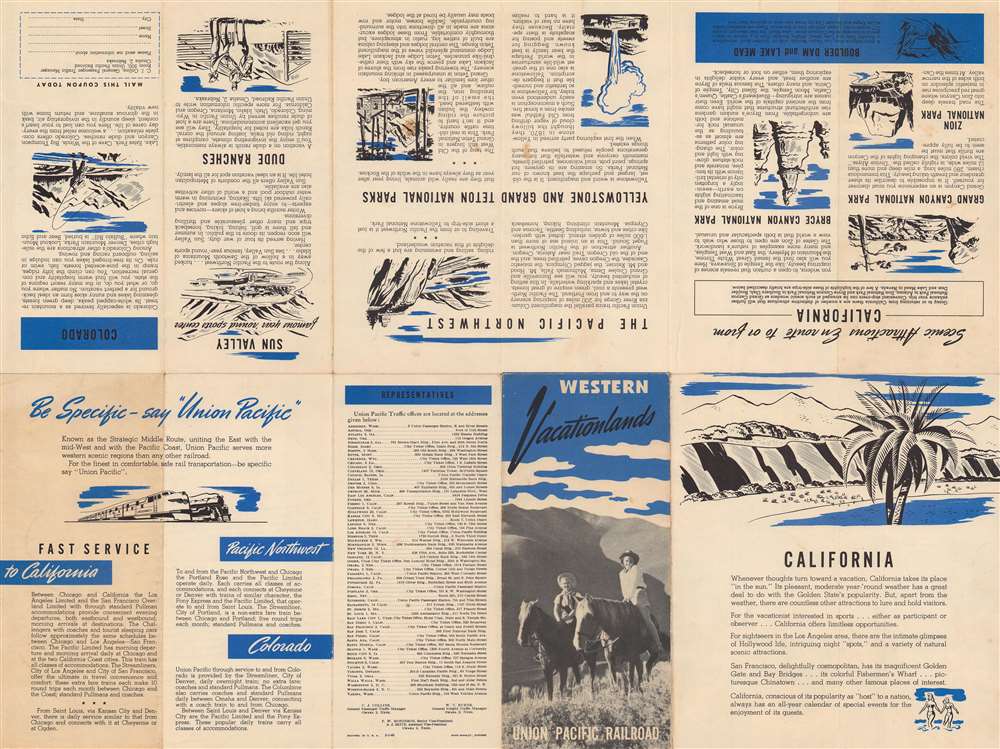Digital Image: 1946 Willmarth Pictorial Tourist Map of the Western United States
WesternVacationlands-willmarth-1946_d
Title
1946 (dated) 18 x 23.75 in (45.72 x 60.325 cm)
Description
FOR THE ORIGINAL ANTIQUE MAP, WITH HISTORICAL ANALYSIS, CLICK HERE.
Digital Map Information
Geographicus maintains an archive of high-resolution rare map scans. We scan our maps at 300 DPI or higher, with newer images being 600 DPI, (either TIFF or JPEG, depending on when the scan was done) which is most cases in suitable for enlargement and printing.
Delivery
Once you purchase our digital scan service, you will receive a download link via email - usually within seconds. Digital orders are delivered as ZIP files, an industry standard file compression protocol that any computer should be able to unpack. Some of our files are very large, and can take some time to download. Most files are saved into your computer's 'Downloads' folder. All delivery is electronic. No physical product is shipped.
Credit and Scope of Use
You can use your digial image any way you want! Our digital images are unrestricted by copyright and can be used, modified, and published freely. The textual description that accompanies the original antique map is not included in the sale of digital images and remains protected by copyright. That said, we put significant care and effort into scanning and editing these maps, and we’d appreciate a credit when possible. Should you wish to credit us, please use the following credit line:
Courtesy of Geographicus Rare Antique Maps (https://www.geographicus.com).
How Large Can I Print?
In general, at 300 DPI, you should at least be able to double the size of the actual image, more so with our 600 DPI images. So, if the original was 10 x 12 inches, you can print at 20 x 24 inches, without quality loss. If your display requirements can accommodate some loss in image quality, you can make it even larger. That being said, no quality of scan will allow you to blow up at 10 x 12 inch map to wall size without significant quality loss. For more information, it is best consult a printer or reprographics specialist.
Refunds
If the high resolution image you ordered is unavailable, we will fully refund your purchase. Otherwise, digital images scans are a service, not a tangible product, and cannot be returned or refunded once the download link is used.
Cartographer S
William Andrew Willmarth (November 20, 1898 - October 3, 1984) was an American artist. Born in Chicago, Illinois, Willmarth served in the armed forces during World War I, possibly with the Merchant Marine. His family moved to Omaha, Nebraska, in 1920, where he worked at the Holland Furnace Company with his older brother Kenneth and his father Philip, who managed the company. The following year, Willmarth and his brother are both listed as commercial artists in the Omaha city directory. The Willmarths continued making commercial art through the 1920s, and William won second prize in a nationwide contest for the best Citizens' Military Training Camps poster in 1926. Throughout these years the majority of their work was signed simply as 'The Willmarths'. The Willmarths first produced work for the Union Pacific Railroad in 1930, when they designed the covers for two Union Pacific brochures promoting Yellowstone National Park. Willmarth began creating work for Union Pacific more regularly beginning in 1932, when two of his posters were selected as winners in a poster contest to promote travel in the western United States. He also designed one of the posters for President Roosevelt's 1934 'National Parks Year' campaign. Beginning in 1936, when the Chairman of the Union Pacific Railroad W. Averell Harriman opened his Sun Valley Resort in Idaho, the Willmarths began creating numerous promotional pieces for the resort, which was publicized as the first destination winter resort in the country. Both Willmarths created maps, posters, and other pieces promoting Sun Valley. During World War II, William and his brother created several pieces for the 'Keep 'Em Rolling' war posters series. Then in 1945, the brothers created a series of eleven paintings for Union Pacific, one for each Western state served by the Union Pacific. Known as the 'Your America' series, these works promoted a Union Pacific sponsored radio show of the same name and appeared as posters and print ads. They were even turned into a calendar and postcards. The Willmarths also created a series of magazine advertisements promoting the Union Pacific Streamliners from 1948 until 1950. William married Julia Morrison in April 1923. The couple had five children, three daughters and two sons. William and Julia moved to Tuscon, Arizona in 1958, where he likely retired from the commercial art business. However, he continued creating art for the rest of his life, even winning the 'color the bus' contest (meant to find a new color scheme for the city's buses) in Tuscon in 1976. Apparently, he entered 'for the fun of it'. Julia passed away on November 12, 1968, and William remarried on September 17, 1969, to Barbara Henderson. More by this mapmaker...
Rand, McNally and Co. (fl. 1856 - present) is an American publisher of maps, atlases and globes. The company was founded in 1856 when William H. Rand, a native of Quincy, Massachusetts, opened a print shop in Chicago. Rand hired the recent Irish immigrant Andrew McNally to assist in the shop giving him a wage of 9 USD per week. The duo landed several important contracts, including the Tribune's (later renamed the Chicago Tribune) printing operation. In 1872, Rand McNally produced its first map, a railroad guide, using a new cost effective printing technique known as wax process engraving. As Chicago developed as a railway hub, the Rand firm, now incorporated as Rand McNally, began producing a wide array of railroad maps and guides. Over time, the firm expanded into atlases, globes, educational material, and general literature. By embracing the wax engraving process, Rand McNally was able to dominate the map and atlas market, pushing more traditional American lithographic publishers like Colton, Johnson, and Mitchell out of business. Eventually Rand McNally opened an annex office in New York City headed by Caleb S. Hammond, whose name is today synonymous with maps and atlases, and who later started his own map company, C. S. Hammond & Co. Both firms remain in business. Learn More...




